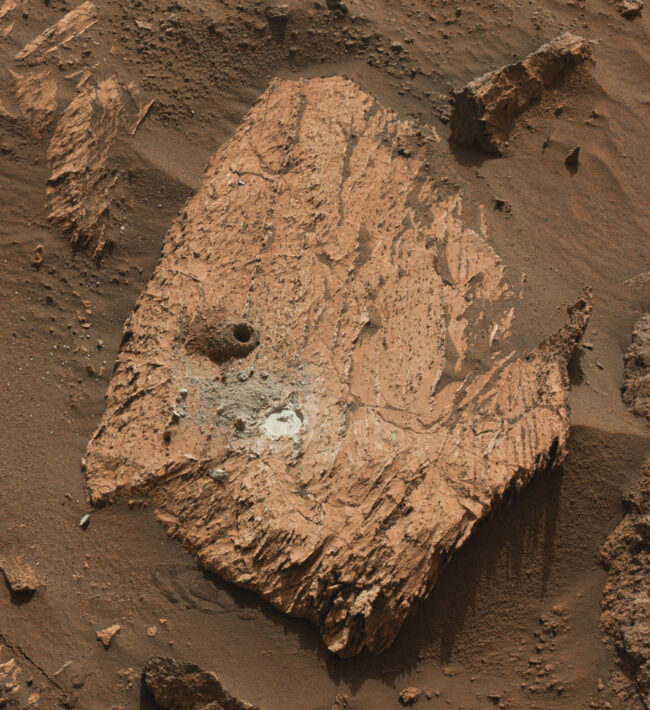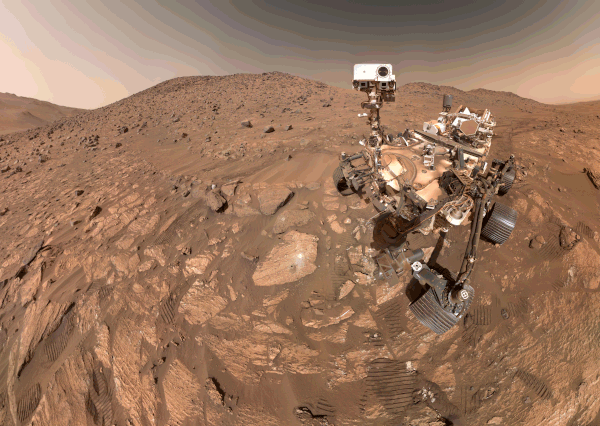Now Reading: NASA says Mars rock is a potential biosignature
-
01
NASA says Mars rock is a potential biosignature
NASA says Mars rock is a potential biosignature


NASA says Mars rock is a potential biosignature
On September 10, 2025, NASA held a press conference to discuss a rock sample from Mars called Sapphire Canyon. The Perseverance rover drilled this rock sample from an area on Mars thought to be an ancient river delta. Intriguingly, the rock is peppered with black spots called poppy seeds and lighter spots with dark rims resembling leopard spots. And now, NASA is saying that, so far, they have no other good explanation for what created these spots except for biological processes. It’s not yet confirmed, but signs point to life.
Nicola (Nicky) Fox is the associate administrator for NASA’s Science Mission Directorate. Fox said:
We think they are potentially made by some form of ancient life. It’s a signature. A sort of leftover sign. It’s not life itself … Nothing that’s currently there. It could be made by ancient life. … It’s the equivalent of seeing leftover fossils. This certainly is not the final answer.
Katie Stack Morgan, the Deputy Project Scientist of the Mars 2020 rover mission, said:
The discovery of a potential biosignature … requires further work to confirm.
So the search for life beyond Earth continues. Will life ever be confirmed to have existed on Mars? And, if we do find evidence for life on the planet right next door – in one of the closest places we’ve looked – what might that mean for life in our universe?
Perseverance rover on Mars
The Perseverance rover touched down in Mars’ Jezero Crater in February 2021. Scientists chose Jezero Crater because it appears the area was a lake a few billion years ago. It’s possible this lake was once habitable, and if so, it might still hold evidence of ancient life. Ken Farley at Caltech in Pasadena, California, is the project scientist for the Perseverance mission. He said:
We picked Jezero Crater as a landing site because orbital imagery showed a delta; clear evidence that a large lake once filled the crater. A lake is a potentially habitable environment, and delta rocks are a great environment for entombing signs of ancient life as fossils in the geologic record. After thorough exploration, we’ve pieced together the crater’s geologic history, charting its lake and river phase from beginning to end.
Perseverance has been collecting rocks from the ancient lakebed and the attached delta for the past few years. It has been taking some onsite measurements and images of the rocks while also collecting specimens for a possible future return mission. This Mars Sample Return mission is still in the concept phase, embroiled with budget issues. But as of July 2025, Perseverance has already filled 33 tubes of the 38 samples it has available to store for a future pick-up mission.

Sapphire Canyon is sample 25
The 25th sample Perseverance collected is Sapphire Canyon, drilled from Cheyava Falls in Neretva Vallis. The sample is notable for various reasons. For one, it’s covered in small black spots that scientists call poppyseeds. But it also has larger spots, lighter in the center with dark borders, that scientists call leopard spots. Notably, back in 2024 when NASA announced the discovery of the rock, it said Sapphire Canyon:
possesses qualities that fit the definition of a possible indicator of ancient life.
Why is that? Well, first, Perseverance used its SHERLOC instrument to analyze the rock. It found organic compounds. Those are carbon-based molecules that are the building blocks of life on Earth. But it is not yet, however, proof of life on Mars.
Secondly, those spots could be a sign of chemical reactions due to microbial life. We’ve seen similar markings on earthly rocks. And on Earth, those patterns are often associated with biology. They are, essentially, the fossilized record of microbes living in the subsurface.
What’s new?
If you’re a regular reader of EarthSky, this information doesn’t sound new to you. So, what was the press conference for? Basically, today we learned there is a new study on these spots that has been peer-reviewed. And while the most likely answer to what created these spots is processes with a biological origin, life has not been confirmed on Mars. But NASA and scientists are excited about the results so far. Now, the next step to confirm it would be to bring home a sample. Will NASA greenlight the Mars Sample Return mission? That remains to be seen.
In fact, the scientists of the new paper write, in the last sentence of their abstract (emphasis mine):
Ultimately, we conclude that analysis of the core sample collected from this unit using high-sensitivity instrumentation on Earth will enable the measurements required to determine the origin of the minerals, organics and textures it contains.

Bottom line: NASA said at a press conference on September 10, 2025, that a Mars rock explored by the Perseverance rover is a potential biosignature. Markings on the rock might be a sign of ancient life.
Source: Redox-driven mineral and organic associations in Jezero Crater, Mars
Via NASA press conference, September 10, 2025
The post NASA says Mars rock is a potential biosignature first appeared on EarthSky.
Stay Informed With the Latest & Most Important News
Previous Post
Next Post
-
 012024 in Review: Highlights from NASA in Silicon Valley
012024 in Review: Highlights from NASA in Silicon Valley -
 02Panasonic Leica Summilux DG 15mm f/1.7 ASPH review
02Panasonic Leica Summilux DG 15mm f/1.7 ASPH review -
 03How New NASA, India Earth Satellite NISAR Will See Earth
03How New NASA, India Earth Satellite NISAR Will See Earth -
 04And Thus Begins A New Year For Life On Earth
04And Thus Begins A New Year For Life On Earth -
 05Astronomy Activation Ambassadors: A New Era
05Astronomy Activation Ambassadors: A New Era -
 06From Polymerization-Enabled Folding and Assembly to Chemical Evolution: Key Processes for Emergence of Functional Polymers in the Origin of Life
06From Polymerization-Enabled Folding and Assembly to Chemical Evolution: Key Processes for Emergence of Functional Polymers in the Origin of Life -
07SpaceX launch surge helps set new global launch record in 2024




















